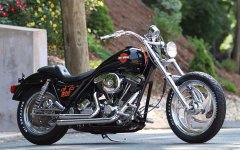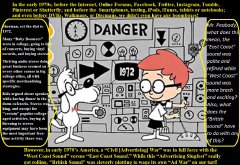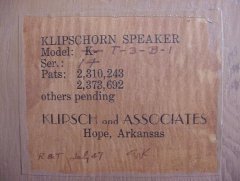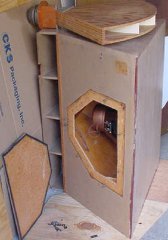-
Posts
1718 -
Joined
-
Last visited
-
Days Won
2
Fjd last won the day on January 16 2016
Fjd had the most liked content!
Profile Information
-
Gender
Not Telling
-
Location
Soon to be "living in the midrange"
Recent Profile Visitors
The recent visitors block is disabled and is not being shown to other users.
Fjd's Achievements

Forum Veteran (4/9)
1.3k
Reputation
-
-
-
Thanks guys for the short “Wayback Machine” trip, which took me back to the early 1970’s; and just where is it that you have actually gone, Joe DiMaggio? It has been a really long time since I’ve heard anyone reference “California speaker" or "California sound,” and I’m sure you both know most of the following, since I suspect you both were buying stereo gear in the 1970’s, but it may be of interest to those that were too young, not born yet or just happened to start buying audio gear later in life. If we consider the time-period USNRET referenced of 1974 - 76 and the “definitions” describing sound of that time-period, it was both that upper midrange peak (L100 had ~ 6dB at 9Khz) and the thumping, more punchy bass, which was different than most any of the retail consumer speaker choices before it (e.g., Acoustic Research acoustic suspension designs or sealed box designs), which actually set the JBL L100 apart and tended to define the “California sound” or “West coast sound” for the general retail consumers. It seems that, in general, with technological advances, distribution changes eliminating regional barriers and introducing wide-scale distribution that now includes international brands, marketing changes, life style changes, among other changes have blurred the lines these days where, Jolting Joe has left and gone away. Generally, in 1970's America, I remember that there tended to be “two main camps” for loudspeaker design and sound characterizations. While I’ve heard it called Boston-sound and California-sound in relation to the different approaches with certain “high-level design criteria” for loudspeakers, where I grew up in the Northern part of the mid-West, we tended to characterize it more by the very general geographical manufacturing locations of the companies building the speakers and called it the “East coast sound” vs. “West coast sound.” Of course, living in the Northern part of the mid-West, in many instances we tried to “spurn” both the East coast and West coast in our decision making process, hence choosing the designs of a certain Southern mid-West manufacturer located in Arkansas that was building Klipsch loudspeakers. Given the above, the East coast loudspeaker manufacturers tended to be located around the Boston area and used acoustic suspension designs or sealed boxes such as the designs from Acoustic Research, Advent, Allison Acoustics, Boston Acoustics, KLH, etc. The acoustic suspension designs were harder to drive, needed a lot more amplifier power, and were generally described as having smoother, more neutral, “accurate” sound with deep, clean bass; although even today, I realize that it is not unusual for 15 different people to often define “accurate” or the other sound characteristics in 15 different ways. The West coast loudspeaker manufacturers, such as JBL, Altec Lansing, Bozak, Cerwin Vega, etc. tended to have the ported enclosures or bass reflex enclosures; and certain models used horns. At the time, these designs generally were characterized as having higher sensitivity needing less amplifier power, “brighter” sound, and “punchy, thumping bass,” which seemed more suitable to many people for rock n’ roll and jazz music of that period. It’s 1974 and you just pick up Aerosmith's new second album, “Get Your Wings,” which just hit the record store shelves. Drop the needle down on “Train kept a Rollin,” then sit back and take it all in through a pair of JBL L100s. Who knew at the time, that it could possibly get any better than that? The internet forums are full of anecdotal correlations and theories regarding the divergence in the West coast designs from the East coast designs. Some of the more common appear to be related to the requirements and needs of the specific industries served by the West coast manufacturers, for which design goals tended to filter to the retail consumer products, where the commercial requirements were different than the perceived requirements and needs of the retail consumer customers served by the East coast manufacturers. In addition, for similar reasons related to access, the actual commercial products were more accessible to those on the West coast. For example, Altec, JBL, and other West coast manufacturers had been designing for the requirements and needs of companies that did business in the recording industry and the movie film industry, where these commercial companies were also based in similar geographical locations at the time; and while we can see that certain design goals found their way into consumer retail products, there were various barriers at the time for more wide-scale acceptance, merchandising, marketing and distribution. Some of the anecdotal correlations outline that the East coast manufacturers may have been more consumer retail products focused and more influenced by British designs and similar, smaller living situations in the big cities such as New York, Boston, and Philadelphia, which included much larger concentrations of apartment dwellers where physically smaller speakers were needed for the smaller living spaces. Anyway, it can be fun to speculate about the reasons, and this little nostalgic trip down “memory lane” back to the early 1970’s has been a fun little diversion, as I procrastinate momentarily with the income tax filing deadlines fast approaching.
-
The specification sheet that AaronB123 is looking at is for a behind the screen cinema system in an auditorium with a size that is approximately 5,000 ft2 or 465 m2 that will seat up to 350 people.
-
Religion is the topic to discuss, Gus Or heap on the Mods some abuse, Bruce Then threaten to sue, Drew And find yourself free
-
Here are a three links that some may find interesting (or maybe not) that includes some of the history of the Magnolia centers that reaches back to the 1950s. Original purchase of Magnolia by Best Buy finalized during December 2000 http://www.bizjournals.com/seattle/stories/2000/12/18/daily4.html Closed the Magnolia Headquarters around 2009 http://www.cbsnews.com/news/best-buy-still-trying-and-failing-to-make-magnolia-bloom/ Magnolia history timeline starting with the 1950s on the Magnolia website http://www.magnoliaav.com/about-us/history
-
I think that pbphoto hit on part of the issue regarding room set-up in these types of store environments. In my experience I have found that there is a lot of variability in the source (certain locations seemed to be streaming low quality mp3 files, while others put a lot of work into using a quality source that may include a quality CD player) and room set-up for the Best Buy Magnolia stores. In many respects, the source material and room set-up just might be the most critical aspects of a music reproduction system. In addition, it seems that not all Magnolia stores are equal in relation to equipment that it stocks either. A couple of years ago the "Magnolia Design Centers" typically had the "high-end" audio equipment such as McIntosh, while the Magnolia Home Theater rooms are scaled down; however, that may have changed. Either way, since the economic downturn in 2008, it seems like they took a huge step back with the Magnolia concept and were scaling back and letting go knowledgeable employees. Since it appears that Youthman experienced an enjoyable combination of McIntosh amplifiers and B&W speakers detailed in his post below, hopefully his experience wasn't an isolated experience and the implementation of the Magnolia concept is making a comeback and improving across more stores.
-
Here you go Dave and they have a name for it, "sextortion." Since the person has already given you a webcam address, there is a high probability that you have been targeted for blackmail in one of those webcam video extortion scams. The scam has been around for several years now and I mostly read reports in relation to the blackmail of teenagers; however, they have been known to target older gentlemen with large Klipsch loudspeakers.
-
Last night I was on a quick "archeological dig" through the forum and it appears that I may have stumbled across Klipschorn No. 14. That was the first time I had seen interior louvered shutters covering a Klipschorn.
-
Nice post, you seem very self-aware. Interesting though, in that buying audio gear just might be somewhat similar to navigating a long-term relationship as this is very similar to what I talk with the kids about regarding long-term relationships and marriage. To learn a lot about themselves including what they like, and to think hard about the compromises that they are willing to make and accept. Understand the life issues they are willing to negotiate and those that are non-negotiable because there will be compromises and the "cost" can be high. Today he may think that "she knows me so well that she can finish my sentences," while tomorrow it can easily become, " ***** quit interrupting while I'm talking."
-
I was on a quick "archeological dig" through the forum and it appears that I may have stumbled across Klipschorn No. 14. Interesting information provided by Trey and ZAKO (may he RIP). I had not seen interior louvered shutters on a Klipschorn until now. The serial number tag indicating Klipschorn Speaker No. 14. Woofer and woofer motor board tag information I wonder what the ESR measures are for those capacitors?
-

587843efd1e98-KlipschornNo14wooferdetailtagpost-13602-700.jpg
Fjd posted a gallery image in Members Albums Category
-

587843ec77ad8-KlipschornNo14serialnumbertagpost-13602-700.jpg
Fjd posted a gallery image in Members Albums Category
-

587843e8ae8f8-KlipschornNo14post-13602-1381924992700.jpg
Fjd posted a gallery image in Members Albums Category








